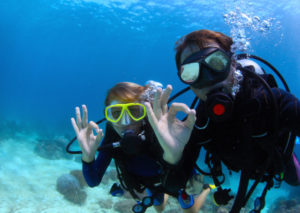Although overwhelmingly safe, diving does feature some inherent risks. When facing in-water difficulties, divers use several strategies in order to handle these situations. They can choose to either manage the situation and dive or work with a buddy to overcome the challenge. Finally, a diver may choose to abort the dive.
The way a diver chooses to handle an in-water situation depends largely on the individual, how serious they perceive the problem to be, their in-water experience, and the characteristics of that particular dive. Here then are the three “C’s” of how divers handle in-water difficulties.
Consolidation
When faced with an uncomfortable or problematic situation underwater, divers first try to use what researchers Kay Dimmock and Erica Wilson call ‘consolidation.’ If the problem is not life-threatening — say, a repeatedly fogging mask — they choose to divert their attention away from the problem and focus on more enjoyable elements of the dive. They tend to either just accept the situation or to use positive self-talk to encourage themselves to stay calm and to remind themselves that they are safe. By consolidating the situation divers remain autonomous and can identify problem situations and thus handle these challenges better.
Cooperation

In some cases, divers will turn to their buddies for assistance. By accepting their buddy’s support, divers can remain calm in uncomfortable situations. This provides the confidence to carry on with a dive when they might have otherwise cancelled. Physical contact from a buddy is especially effective in helping a stressed diver relax and continue their dive. Debriefings are also an effective form of social support where divers can share their experiences and speak about the problem situations they encountered during the dive. This encourages learning and fosters a safe environment for divers to raise their concerns.
Cancelling
In extreme situations, such as equipment malfunctions or running low on air, divers would choose to cancel their dive. This usually happens in situations when staying in the water poses a great personal risk. It must be said, though, that cancelling a dive should not only apply in ‘extreme’ cases, but any time when a diver does not feel comfortable completing the dive.
This relates to what the researchers call ‘environmental load.’ This is an individual’s threshold of how much they can handle in a given situation. When they reach this threshold, they tend to remove themselves from the environment. In serious situations, divers shift their focus from other parts of the dive to the problem. They evaluate and negotiate whether to cancel the dive or not. This gives them a sense of control as they realize that their safety is most important.
The risks and uncertainty related to scuba diving are part of what attracts divers to the sport in the first place. It challenges them and offers them an opportunity to have new and unique experiences. These risks and uncertainty, however, can turn dangerous when divers face in-water difficulties and don’t know how to address them. With skill and experience divers, though, divers can control and mitigate a problem situation. Following the three C’s is a good start.

